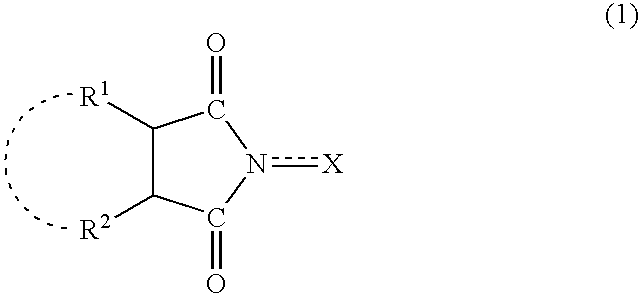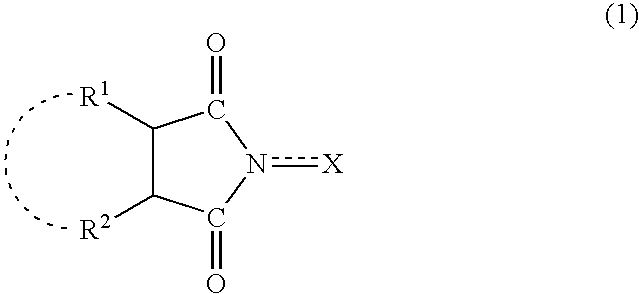Method for separation of reaction products from catalysts
a technology of reaction products and catalysts, applied in the direction of catalyst regeneration/reactivation, organic compound/hydride/coordination complex catalysts, physical/chemical process catalysts, etc., can solve the problem of deteriorating the quality of the end product, few reports have been made on a method for separating a reaction product, and achieve the effect of efficient and simple separation
- Summary
- Abstract
- Description
- Claims
- Application Information
AI Technical Summary
Benefits of technology
Problems solved by technology
Method used
Image
Examples
example 1
[0078]In a flask 316.1 g (1.1 mol) of valencene with a purity of 71% by weight, 22.28 g (0.14 mol) of N-hydroxyphthalimide, 6.97 g (0.028 mol) of cobalt(II) acetate tetrahydrate, 29.93 g (0.084 mol) of tris(acetylacetonato)cobalt(III), and 3230 g of acetonitrile were placed and were stirred at 40° C. at a pressure of 13 kgf / cm2 (=1.3 MPa) for 2 hours under flow of air at a rate of 150 L (under standard conditions) per hour. The resulting mixture was further treated with 22.84 g (0.14 mol) of N-hydroxyphthalimide with stirring at 40° C. for 2 hours. The reaction mixture was analyzed by gas chromatography and was found that a target compound nootkatone and nootkatol were produced in yields of 53.7% and 1.4%, respectively, with a conversion from valencene of 100%. The reaction mixture was further analyzed by high-performance liquid chromatography and was found to contain 4.4 g of N-hydroxyphthalimide, 0.7 g of phthalimide, and 18.8 g of tris(acetylacetonato)cobalt(III).
[0079]The above-...
example 2
[0080]In a flask 40.87 g (142 mmol) of valencene with a purity of 71% by weight, 4.89 g (30 mmol) of N-hydroxyphthalimide, 0.49 g (2 mmol) of cobalt(II) acetate tetrahydrate, 1.43 g (4 mmol) of tris(acetylacetonato)cobalt(III), 0.58 g (2 mmol) of cobalt nitrate hexahydrate [Co(NO3)2.6H2O], and 360 g of acetonitrile were placed and were stirred at 40° C. at a pressure of 13 kgf / cm2 (=1.3 MPa) for 3 hours under flow of air at a rate of 11.2 L (under standard conditions) per hour. The reaction mixture was analyzed by gas chromatography and was found that a target compound nootkatone and nootkatol were produced in yields of 67.9% and 5.6%, respectively, with a conversion from valencene of 99%. The reaction mixture was further analyzed by high-performance liquid chromatography and was found to contain 0.04 g of N-hydroxyphthalimide, 0.09 g of phthalimide, and 0.59 g of tris(acetylacetonato)cobalt(III).
[0081]The above-obtained reaction mixture was filtrated through a filter paper, and a f...
PUM
| Property | Measurement | Unit |
|---|---|---|
| pressure | aaaaa | aaaaa |
| pressure | aaaaa | aaaaa |
| affinity | aaaaa | aaaaa |
Abstract
Description
Claims
Application Information
 Login to View More
Login to View More - R&D
- Intellectual Property
- Life Sciences
- Materials
- Tech Scout
- Unparalleled Data Quality
- Higher Quality Content
- 60% Fewer Hallucinations
Browse by: Latest US Patents, China's latest patents, Technical Efficacy Thesaurus, Application Domain, Technology Topic, Popular Technical Reports.
© 2025 PatSnap. All rights reserved.Legal|Privacy policy|Modern Slavery Act Transparency Statement|Sitemap|About US| Contact US: help@patsnap.com



